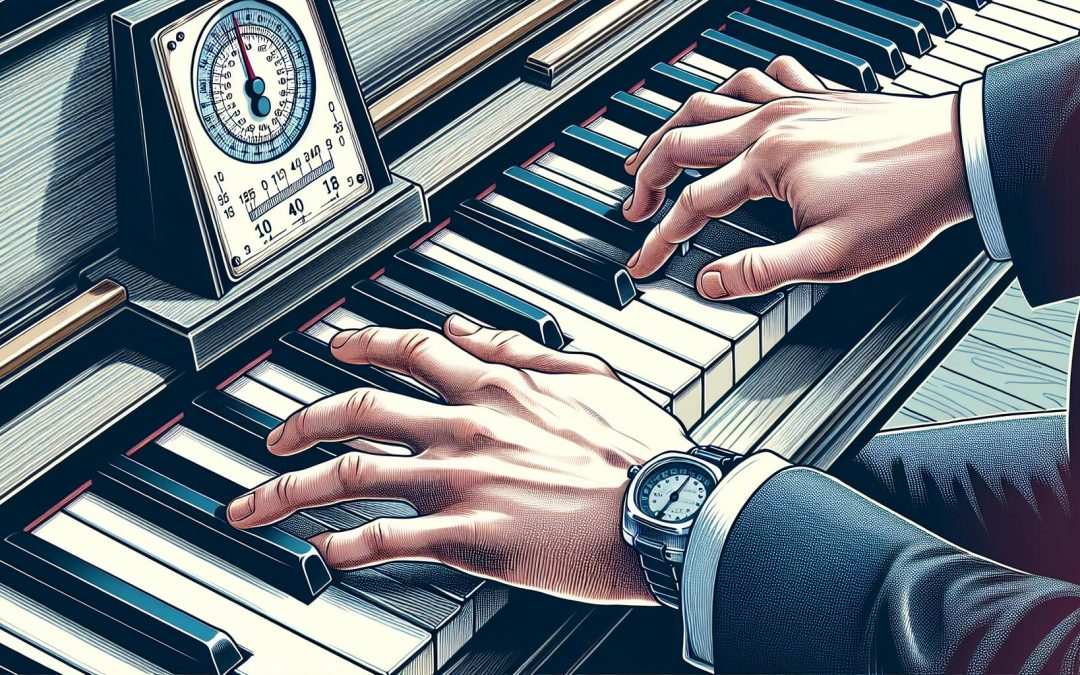Playing fast passages on the piano can feel like a thrilling high-speed chase. There's excitement, adrenaline, and the sheer joy of music flowing under your fingertips. But it's also where many pianists hit a wall, stumbling over notes and losing the melody in a blur of missteps.
The good news? Mastering those lightning-fast sequences isn't reserved for the virtuosos among us. It's about technique, practice, and a few secret strategies that can turn those tricky passages into a smooth, exhilarating ride. Whether you're a budding Beethoven or a hobbyist looking to level up, unlocking the secrets to flawless fast playing is about to change your musical journey.
So, let's dive into the world of precision, speed, and effortless performance. It's time to leave those mistakes in the dust and let your fingers fly across the keys with confidence and flair.
Understanding Piano Technique for Fast Passages
When embarking on the journey to master fast passages on the piano, pianists must first dive deep into the intricacies of piano technique. Good technique is the backbone of playing quickly and fluently, allowing musicians to navigate the keyboard with ease. It involves a combination of finger strength, agility, and the efficient use of gravity to minimize effort while maximizing impact.
One of the foundational aspects of technique that facilitates rapid playing is fingering. Selecting the right fingers for each note is like plotting a course through a complex maze. Optimal fingering choices can significantly reduce the physical distance fingers must travel and streamline transitions between notes. This isn’t just about following the suggestions in sheet music; it’s about understanding one's own hands and making adjustments based on personal comfort and the uniqueness of each piece.
Hand position also plays a critical role in mastering fast passages. A relaxed, naturally curved hand position helps prevent tension and fatigue, which are common obstacles when playing at high speeds. Pianists learn to maintain this optimal position even as they move across the keyboard, ensuring that each finger is ready to strike with precision and clarity.
Another technique often overlooked is economy of motion. Efficiency is key when playing fast. Every unnecessary movement adds milliseconds of delay, which, in a rapid passage, can disrupt the flow and lead to mistakes. By minimizing the motion of fingers, hands, and even arms, pianists can maintain a fluid, continuous sound, even at breakneck tempos.
Synchronization between the hands is yet another critical factor. Fast passages often require both hands to work together seamlessly, like gears in a well-oiled machine. Achieving this level of coordination demands meticulous practice, starting slow and gradually increasing the tempo, ensuring that both hands are perfectly aligned every step of the way.
Many pianists turn to practice techniques specifically designed to enhance speed and accuracy. These might include:
- Slow practice: Playing passages at a fraction of the intended speed to ensure accuracy and evenness.
- Segmentation: Breaking down fast passages into smaller, manageable sections to focus on difficult areas.
- Rhythmic variations: Altering the rhythm of the passage to practice agility and flexibility in finger movement.
- Metronome use: Gradually increasing the metronome speed to build up to the desired tempo without sacrificing precision.
Practicing Strategies to Improve Speed and Accuracy

In the quest to master fast passages on the piano without mistakes, pianists often find that the devil is in the details of how they practice. Practicing strategies are pivotal in transforming a struggle with speed and accuracy into seamless and swift execution. Here, we delve into techniques that can significantly elevate a pianist's ability to play quickly and flawlessly.
Start Slowly and Gradually Increase the Tempo
It might seem counterintuitive, but starting at a slow pace is fundamental. Playing slowly allows musicians to fully understand every note and its timing, ensuring that they can execute each movement with precision. As they grow more comfortable, gradually increasing the tempo helps embed the right movements into muscle memory. A useful tool in this process is a metronome, which ensures that tempo increases are measured and consistent.
Segmentation
Breaking down fast passages into smaller, manageable sections or segments is another effective strategy. Learning and perfecting each segment before stitching them together allows pianists to focus on the most challenging parts without being overwhelmed. This method not only enhances accuracy but also boosts confidence as each segment is mastered.
Use of Rhythmic Variations
Practicing fast passages with different rhythmic patterns can be particularly beneficial. By altering rhythms during practice, pianists force their fingers to adapt to new configurations, improving flexibility and responsiveness. This method strengthens the fingers and enhances their independence, making it easier to tackle the actual rhythm of the passage.
Focus on Finger Independence and Strength
Finger exercises that promote independence and strength are essential for pianists who aim to play fast passages flawlessly. Exercises like scales, arpeggios, and Hanon exercises can be tailored for this purpose. Strong, independent fingers are more capable of executing rapid, precise movements.
Prioritize Accuracy Over Speed
While the goal is to play fast, prioritizing accuracy over speed in the initial stages of learning is crucial. Playing notes correctly before focusing on playing them quickly ensures that precision is not sacrificed. Speed should be a product of comfort and familiarity with the passage, not the initial goal.
Mental Practice
Visualizing the keyboard and imagining the physical movements required to play a piece can be a potent practice tool. Mental practice allows pianists to prepare and rehearse the motor skills needed for fast passages without physical strain, offering a different form of muscle memory reinforcement.
Utilizing Finger Exercises to Enhance Dexterity

Enhancing finger dexterity is crucial for pianists aiming to master fast passages without mistakes. Dexterity allows pianists to move their fingers quickly and independently, a skill that becomes especially important when navigating the complexities of rapid sequences. One effective method to improve this aspect is through dedicated finger exercises, designed to challenge and thereby strengthen each finger.
First off, scales and arpeggios are the backbone of finger training. They're not just warm-up exercises but foundational tools that build finger strength and agility. By practicing these daily, pianists can develop muscle memory and increase the speed at which they play. It’s recommended to start at a slow tempo, focusing on precision and evenness in touch, before gradually increasing the speed.
Another key set of exercises comprises Hanon and Czerny studies. These exercises are specifically tailored to enhance finger independence and flexibility, qualities that are indispensable for executing fast passages flawlessly. Each exercise targets different technical challenges, providing a comprehensive workout for the hands. Integrating these into daily practice routines ensures that each finger becomes more adept at moving swiftly and accurately.
Here is a quick overview of the benefits obtained from consistent practice of these exercises:
| Exercise Type | Benefits for Dexterity |
|---|---|
| Scales and Arpeggios | Builds strength and agility |
| Hanon Studies | Improves finger independence |
| Czerny Exercises | Enhances flexibility and control |
In addition to traditional exercises, pianists should also consider incorporating modern finger exercises that leverage new teaching methods and technologies. Apps and online tutorials offer interactive sessions, making practice both effective and engaging. These tools often provide real-time feedback, allowing players to correct their technique as they go.
Incorporating a variety of exercises into one's practice routine can prevent monotony and keep the training engaging. It’s vital to approach these exercises with a mindful attitude, paying close attention to the movement of each finger and ensuring that each note is played with intention and precision.
One often overlooked aspect of finger dexterity is the need for regular breaks. Just like athletes, pianists must rest their muscles to avoid strain and potential injury. Short, focused practice sessions with ample rest in between prove more beneficial than long, exhaustive practice marathons. This approach not only aids in physical recovery but also helps in mental assimilation of the skills practiced.
Mental Approaches for Tackling Fast Passages

When pianists aim to play fast passages without mistakes, focusing solely on physical techniques might not suffice. Delving into the mental strategies can significantly enhance their ability to master these challenging sections. Understanding and employing the right mindset is key to overcoming the hurdles fast passages present.
One critical mental approach is visualization. Before touching the keys, pianists should visualize themselves playing the passage flawlessly. This technique not only prepares the mind for success but also helps in memorizing the notes and their sequences. It's akin to mental rehearsal, where every note and finger movement is played out in the mind's eye, reinforcing the connection between mind and body.
Segmentation plays a vital role as well. Breaking down the passage into smaller, manageable chunks allows for focused attention on each part, making the learning process more digestible. By conquering each segment before moving on to the next, the pianist builds confidence and ensures that every note is played with precision.
Another effective strategy is slow practice. It might seem counterintuitive when the goal is to play fast, but practicing slowly and then gradually increasing the tempo ensures that accuracy and muscle memory are developed. It allows for meticulous attention to dynamics, articulation, and rhythm, which are crucial for expressive performance.
Setting specific goals for each practice session can also greatly improve efficiency. Rather than aimlessly playing through the piece, pianists should set achievable objectives, whether it’s perfecting a certain number of measures or increasing the tempo by a small increment. This focused approach leads to noticeable improvements and keeps motivation levels high.
The use of mental cues can help streamline the learning process. These are short, memorable phrases or words that trigger the correct movements or remind the player of the emotional expression of a passage. Mental cues act as anchors, assisting pianists in navigating through complex sections with ease.
Incorporating mindfulness and relaxation techniques into practice routines can significantly reduce performance anxiety, a common obstacle when playing fast passages. Techniques such as deep breathing, meditation, or even simple stretches can help pianists maintain a calm and focused mindset, essential for executing rapid sequences flawlessly.
Incorporating Slow Practice to Build Muscle Memory

When it comes to mastering the piano, one of the most counterintuitive yet effective strategies is slow practice. For learners striving to play fast passages without mistakes, incorporating slow practice into their routine is essential. This method isn't just about reducing tempo—it's about building a deep, muscular and neurological understanding of the piece.
Slow practice allows pianists to dissect each note, chord, and rhythm with precision. By playing at a reduced speed, they're able to identify and focus on the most challenging parts of the passage. This meticulous approach ensures that every finger movement and key press is deliberate and accurate. Over time, these actions become instinctual, creating a foundation of muscle memory that's crucial for flawless performances.
Moreover, slow practice enables pianists to maintain proper form and technique. Fast passages often tempt players to compromise on posture or hand position in the heat of the moment, leading to potential errors or even injuries. By slowing down, pianists can ensure they're using the correct technique for each note and transition, setting a standard that carries over as they gradually increase the tempo.
- Enhances accuracy and precision
- Builds robust muscle memory
- Encourages proper technique and form
- Allows for focused correction of mistakes
During slow practice sessions, it's beneficial for pianists to use a metronome. This tool ensures a consistent tempo, providing a steady framework to work within. Starting below the target speed, pianists can incrementally increase the metronome's pace as they become more comfortable and confident with the passage. This gradual acceleration helps bridge the gap between slow, deliberate practice and full-speed performance without sacrificing accuracy or technique.
Another productive technique during slow practice is segmentations. By breaking the music into smaller, manageable parts, pianists can concentrate on perfecting each segment before stitching them together into a seamless whole. This method not only simplifies complicated passages but also aids in memorization and understanding of the musical structure.
Practitioners should also be mindful of dynamics and articulation during slow practice. Even at reduced speeds, paying attention to the expressive elements of the piece enriches the practice session. It ensures that when the tempo is increased, the musicality of the passage isn't lost amid the focus on speed and precision.
Conclusion
Mastering fast passages on the piano is no small feat but with patience and the right approach, it's certainly achievable. Remember the power of starting slow to build a solid foundation. This methodical approach not only sharpens your skills but also deepens your musical expression. Incorporating a metronome and breaking down pieces into manageable segments further streamlines your practice. And let's not forget the magic of focusing on dynamics and articulation from the get-go. With these strategies in your toolkit, you'll be playing those rapid sequences flawlessly in no time. Keep at it and watch your piano playing transform.
Harlan Kilstein began playing piano during covid with no piano background at all. He taught himself how to play learning what to do and what not to do.
Today he's an advanced intermediate player and can help you grow in your skills because he learned all this on his own.








